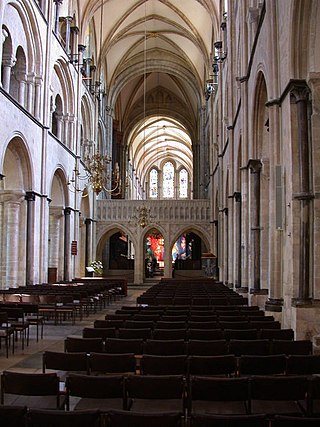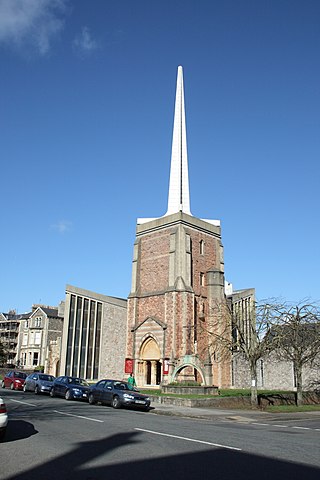
The Diocese of Chichester is a Church of England diocese based in Chichester, covering Sussex. It was founded in 681 as the ancient Diocese of Selsey, which was based at Selsey Abbey, until the see was translated to Chichester in 1075. The cathedral is Chichester Cathedral and the diocesan bishop is the Bishop of Chichester. The diocese is in the Province of Canterbury.

Escomb Church is the Church of England parish church of Escomb, County Durham, a village about 1+1⁄2 miles (2.4 km) west of Bishop Auckland. It is one of the oldest Anglo-Saxon churches in England and one of only four complete Anglo-Saxon churches remaining in England, the others being St Lawrence's Church, Bradford-on-Avon, Greensted Church and All Saints' Church, Brixworth. The church is a Grade I listed building.

St Peter's Church, Bolton-le-Moors, commonly known as Bolton Parish Church, is a Church of England parish church in Bolton, Greater Manchester, England. The parish church, dedicated to St Peter, is an example of the Gothic Revival style. The church is recorded in the National Heritage List for England as a Grade II* listed building, having been designated in 1974. St Peter's is an active parish church in the Diocese of Manchester and is part of the Bolton deanery and Bolton archdeaconry.

St John the Evangelist's Church is an Anglican church in the Preston Village area of Brighton, in the English city of Brighton and Hove. The Grade II listed building, designed by Sir Arthur Blomfield, was started in 1901 but did not take its present form for another quarter of a century. In the meantime, the nearby parish church of Preston was severely damaged by fire, and the new church was granted the parish church status which it still retains.

St Peter's Church is a former Anglican church in the Preston Village area of Brighton, in the English city of Brighton and Hove. The 13th-century building, standing on the site of two older churches, was restored in the late 19th century and again after a serious fire in 1906. It was the parish church of Preston until 1908, when the newly built St John the Evangelist's Church gained this status. The Diocese of Chichester declared St Peter's redundant in 1990, and it is now owned by the Churches Conservation Trust. It has Grade II* listed status, reflecting its architectural and historical importance.

St Mark's Church is a former Anglican church in the Kemptown area of Brighton, part of the English city of Brighton and Hove. Originally intended as the private chapel of the adjacent St Mary's Hall school, it was partly built in 1838 at the request of Frederick Hervey, 1st Marquess of Bristol; but arguments over whether or not it should also be open to the public delayed its completion for more than 10 years. It became the parish church of Kemptown in 1873, but declining attendances resulted in a declaration of redundancy in 1986. At that time it was taken over by the school and became its chapel, nearly 150 years after this was first proposed. The Early English-style stone and concrete structure has been criticised by architectural historians, but has been listed at Grade II by English Heritage for its architectural and historical importance.

St Wilfrid's Church is an Anglican church in the town of Haywards Heath in the district of Mid Sussex, one of seven local government districts in the English county of West Sussex. It is Haywards Heath's parish church, and is the mother church to two of the town's four other Anglican churches. Designed in the Decorated Gothic style by George Frederick Bodley, it was built between 1863 and 1865 as the town began to grow rapidly, and stands in a prominent position on the highest ground in the area. English Heritage has listed it at Grade II* for its architectural and historical importance.

St John the Evangelist's Church is the Church of England parish church of Burgess Hill, West Sussex, England. It is a Gothic Revival church built of local bricks. It was consecrated in 1863 and was the town's first Church of England church. Since then it has administered several other churches in the town as either mission chapels or daughter churches, but all have either closed or been given their own parishes. The church is a Grade II* Listed Building.
John Hannah was a Church of England clergyman and schoolmaster.

St Mary Magdalene's Church is a Greek Orthodox place of worship in St Leonards-on-Sea, a town and seaside resort which is part of the Borough of Hastings in East Sussex, England. Dedicated to Mary Magdalene and built in 1852 for Anglican worshippers in the growing new town of St Leonards-on-Sea, a seaside resort which had been laid out from the 1820s, the church's prominent position on the skyline overlooking the town was enhanced in 1872 by the addition of a tower. No longer required by the Anglican community in the 1980s, it was quickly bought by the Greek Orthodox Church and converted into a place of worship in accordance with their requirements. The alterations were minimal, though, and the building retains many of its original fittings and its "archaeologically correct Gothic" exterior which reflected architectural norms of the early Victorian era. English Heritage has listed the church at Grade II for its architectural and historical importance.

St Peter's Church is a former Anglican church in the Bohemia area of the town and seaside resort of St Leonards-on-Sea, part of the Borough of Hastings in East Sussex, England. Founded in 1883 in response to the rapid residential growth of this part of St Leonards-on-Sea, the "outstanding late Victorian church" was completed and opened in 1885. Architect James Brooks was towards the end of his career but still produced a successful, powerful Gothic Revival design, which was built by prolific local firm John Howell & Son—builders of several other churches in the area.

St Mary's Church is the Anglican parish church of the Hampden Park suburb of Eastbourne, a town and borough in the English county of East Sussex. Originally linked to the church at nearby Willingdon, it later became a separate parish church. The first building was destroyed by a bomb during World War II, and Edward Maufe was commissioned to design a replacement church; the hilltop building, finished in 1954, has been called "one of his most charming designs". English Heritage has listed it at Grade II for its architectural and historical importance.

St Catherine of Siena Church is an Anglican parish church in Cocking, a village in the district of Chichester, one of seven local government districts in the English county of West Sussex.

St Stephen's Church, Gloucester Road, is a Grade II* listed Anglican church located on the corner of Gloucester Road and Southwell Gardens in South Kensington, London, England.

St Hugh's Church or St Hugh of Lincoln Church is a Roman Catholic Parish church in Lincoln, England. It was built from 1892 to 1893. It is situated on the corner of Monks Road and Friars Lane in the city centre. It was designed by Albert Vicars and is a Grade II listed building.

Sacred Heart Church is a Roman Catholic Parish church in Petworth, West Sussex, England. It was built in 1896 and designed by Frederick Walters. It is situated on Angel Street to the north of Petworth Cottage Museum in the centre of the town. It is a Gothic Revival church and a Grade II listed building.

The Church of All Saints is a Church of England parish church in Clifton, Bristol. The church is a grade II listed building. It is located in the Parish of All Saints with St. John Clifton in the Diocese of Bristol.

The Church of St Mary and St Nicholas is a Church of England parish church in Littlemore, Oxford, Oxfordshire. The church is a grade II* listed building. The church was founded by John Henry Newman, later Cardinal Newman of the Roman Catholic Church, and it became a centre of Anglo-Catholicism.

All Saints Church is a Church of England parish church in Tooting, Wandsworth, Greater London. The church was designed by Temple Moore and is a grade II listed building.



















